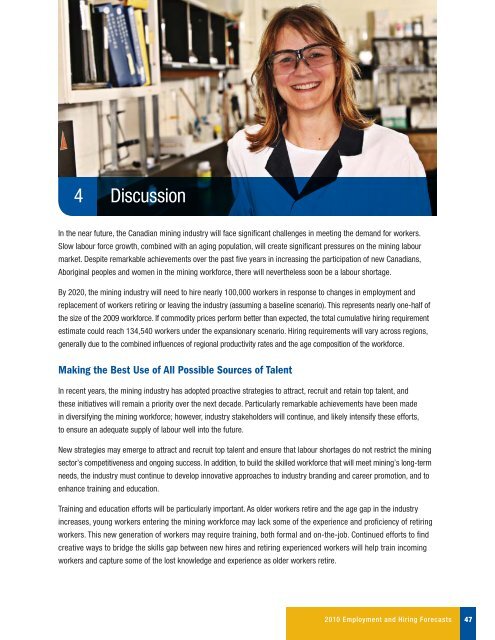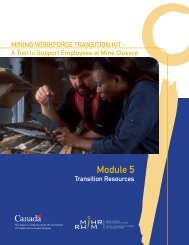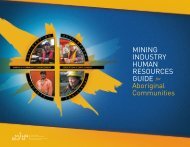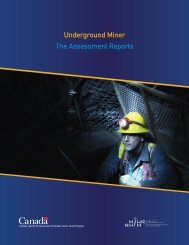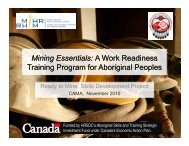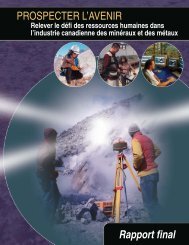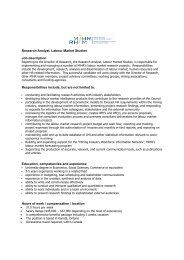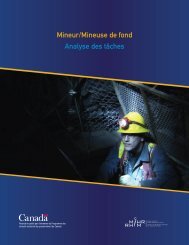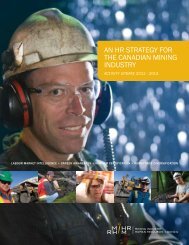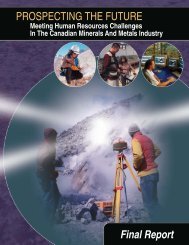Canadian Mining Industry Employment and Hiring Forecasts - MiHR
Canadian Mining Industry Employment and Hiring Forecasts - MiHR
Canadian Mining Industry Employment and Hiring Forecasts - MiHR
You also want an ePaper? Increase the reach of your titles
YUMPU automatically turns print PDFs into web optimized ePapers that Google loves.
4 Discussion<br />
In the near future, the <strong>Canadian</strong> mining industry will face significant challenges in meeting the dem<strong>and</strong> for workers.<br />
Slow labour force growth, combined with an aging population, will create significant pressures on the mining labour<br />
market. Despite remarkable achievements over the past five years in increasing the participation of new <strong>Canadian</strong>s,<br />
Aboriginal peoples <strong>and</strong> women in the mining workforce, there will nevertheless soon be a labour shortage.<br />
By 2020, the mining industry will need to hire nearly 100,000 workers in response to changes in employment <strong>and</strong><br />
replacement of workers retiring or leaving the industry (assuming a baseline scenario). This represents nearly one-half of<br />
the size of the 2009 workforce. If commodity prices perform better than expected, the total cumulative hiring requirement<br />
estimate could reach 134,540 workers under the expansionary scenario. <strong>Hiring</strong> requirements will vary across regions,<br />
generally due to the combined influences of regional productivity rates <strong>and</strong> the age composition of the workforce.<br />
Making the Best Use of All Possible Sources of Talent<br />
In recent years, the mining industry has adopted proactive strategies to attract, recruit <strong>and</strong> retain top talent, <strong>and</strong><br />
these initiatives will remain a priority over the next decade. Particularly remarkable achievements have been made<br />
in diversifying the mining workforce; however, industry stakeholders will continue, <strong>and</strong> likely intensify these efforts,<br />
to ensure an adequate supply of labour well into the future.<br />
New strategies may emerge to attract <strong>and</strong> recruit top talent <strong>and</strong> ensure that labour shortages do not restrict the mining<br />
sector’s competitiveness <strong>and</strong> ongoing success. In addition, to build the skilled workforce that will meet mining’s long-term<br />
needs, the industry must continue to develop innovative approaches to industry br<strong>and</strong>ing <strong>and</strong> career promotion, <strong>and</strong> to<br />
enhance training <strong>and</strong> education.<br />
Training <strong>and</strong> education efforts will be particularly important. As older workers retire <strong>and</strong> the age gap in the industry<br />
increases, young workers entering the mining workforce may lack some of the experience <strong>and</strong> proficiency of retiring<br />
workers. This new generation of workers may require training, both formal <strong>and</strong> on-the-job. Continued efforts to find<br />
creative ways to bridge the skills gap between new hires <strong>and</strong> retiring experienced workers will help train incoming<br />
workers <strong>and</strong> capture some of the lost knowledge <strong>and</strong> experience as older workers retire.<br />
2010 <strong>Employment</strong> <strong>and</strong> <strong>Hiring</strong> <strong>Forecasts</strong><br />
47


